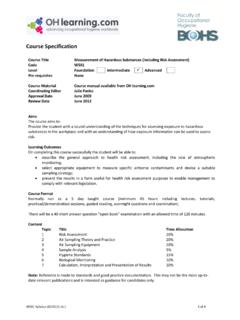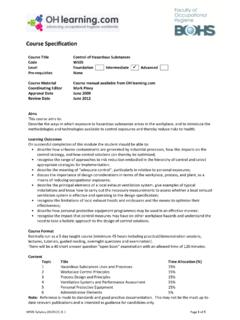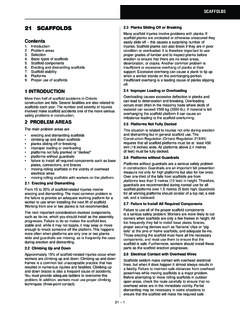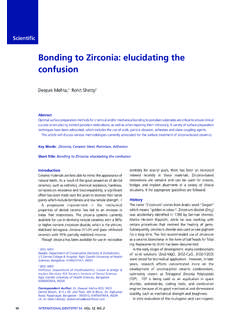Transcription of The British Occupational Hygiene Society - OHLearning
1 W201 Syllabus (010513) 1 of 4 Course Specification Course title Basic Principles in Occupational Hygiene Code W201 Level Foundation Pre-requisites None Course material Available from OH Coordinating editors Kerrie Burton, Jen Hines, Amber Illies, John Dobbie Approval date August 2017 Review date August 2020 Aims The course aims to: Provide an introductory course outlining the broad principles in Occupational Hygiene as the basis for anticipation, recognition, evaluation and control of hazards that can be encountered in the workplace. Learning outcomes On completing this course successfully, the student will have a basic understanding of: The value of Occupational Hygiene and the role of the Occupational hygienist; The range of hazards (physical and chemical) in the workplace; Hazard recognition techniques; Sources and potential routes of exposure; Hazard evaluation, exposure assessment and measurement processes; Methods of controlling exposure; The management of Occupational Hygiene programmes.
2 Course format The course is normally run as a taught course over days (minimum of 36 hours, including practical/demonstration sessions, overnight questions and guided reading). There will be a 20 short answer question open book examination with an allowed time of 60 minutes. Target audience Health and safety professionals, Occupational health specialists [including physicians and nurses] and people wanting to enter the field of Occupational Hygiene . Specialists in subjects such as acoustics, ergonomics, human factors, Occupational psychology, work organisation, biosafety, acoustics, engineering, or analytical chemistry who want a broader appreciation of how their role interfaces with other professions over health issues in the workplace.
3 Content: Topic Title Time allocation 1 introduction 5% 2 Human physiology 15% 3 Chemical hazards recognition 20% 4 Physical hazards recognition 20% 5 Hazard evaluation 20% 6 Control of hazard 20% Detailed breakdown of course content 1 introduction (5%) Definition of Occupational Hygiene History and background of the development of Occupational Hygiene The importance of Occupational Hygiene today Overview of qualifications and careers in Occupational Hygiene 2 Human physiology (15%) An introduction to the physiology of the human body and how it can be affected by Occupational exposure to chemical and physical agents.
4 General metabolism Respiratory system Circulatory system Sight Hearing Heat regulation 3 Chemical hazards recognition (20%) Terminology and information gathering Basic principles of risk assessments, definitions of hazard and risk with brief mention of expert systems and control banding. Hazard and Risk Definition of terms Sources of information: Safety data sheets Guidance documents Literature, websites COSHH essentials Effects on the body Basic principles of toxicology: Routes of entry into the body (inhalation, ingestion, absorption) Metabolism Effects on the body (acute, chronic, systemic and localised) Types of effect (asphyxiation, irritation, trauma, poisoning) Toxicity testing (related terminology) Material form Gases, vapours, aerosols Dusts (respirable and inhalable) Fumes Vapour pressure Hazardous processes Illustration of where common hazardous substance/processes occur and their effects on the body.
5 (Note: The processes listed below should be regarded as examples, some of which will be covered. It is expected that at least one from each group would be used during the course. Individual processes will not be examined.) Mineral materials Silica (quarrying and mining, brick, tile and refractory manufacture, pottery and ceramic, sandblasting, glass manufacture) Asbestos (uses, building surveys, sampling and analysis, remediation/removal) Machine made mineral fibre {MMMF} (manufacture and utilization) Metal processes Metal refining (furnaces, foundries, casting) Machining (cutting, grinding, polishing) Treatments (degreasing, plating, pickling, anodising) Welding (arc welding, gas welding, brazing, soldering)
6 Organic chemical processes Solvents (degreasing and dry cleaning, halogenated hydrocarbons) Paints (application methods: brushed or sprayed) Hydrocarbons and their use (benzene, toluene, xylene, n-hexane) Pesticides (fumigants, spraying, animal dipping) Plastics and polymers )polymer manufacture, rubber manufacture, use of resins in reinforced structures [glass or carbon fibre], isocyanate forms and uses) Pharmaceuticals and fine chemicals (handling and use of bioactive materials and asthmagens) Other processes Woodworking Biological hazards (animals, farming, water treatment, legionella) 4 Physical hazards recognition (20%)
7 Noise (overview of the physics of sound and units of measurement and the effects of noise) Vibration (overview of the physics of vibration and its health effects on the whole body and locally) Thermal stress ( introduction to human responses to the thermal environment and ways to evaluate it) introduction to the electromagnetic spectrum and the various bands of non-ionizing radiation (ultraviolet, infra-red, microwave, lasers) Lighting and assessment in the workplace (effects of poor lighting and glare) Ionising radiation ( introduction to health effects of ionizing radiation, exposure assessment and control techniques and the specialist roles of those who deal with it) introduction to musculoskeletal injuries, ergonomics and the role of the ergonomist Overview of the hazards associated with the use of Display Screen Equipment and how they should be managed introduction to stress and its management in the workplace 5 Hazard evaluation (20%) Exposure assessment Measurement of gases, vapours and dusts An introduction to.
8 Measurements (vapours, gases, aerosols and dust using techniques for spot, personal, static and real time sampling) Analytical methods Hygiene standards and Occupational exposure limits Units of measurement, time-weighting, simple calculations/algebra Compliance with statutory limits Standard setting Biological monitoring and health surveillance Exposure assessment [physical hazards] Assessment of physical hazards An introduction to: Noise measurement Measurement of the thermal environment introduction to principles of assessment of vibration introduction to principles of assessment of lighting and non-ionising radiation introduction to principles of assessment of ionising radiation introduction to principles of ergonomic risk assessment 6 Control of hazard (20%) Outline of the main elements within the hierarchy of control.
9 An introduction to: Elimination/substitution of the hazard Basic principles of ventilation Local exhaust ventilation design Personal protection General ventilation and air conditioning Learning and teaching activities Learning time [hours] Scheduled contact hours: [Note: these timings are indicative only] Lectures 16 Seminars [including homework feedback] 4 Practical sessions and demonstrations 6 Tutorials 2 Examinations [including preparation] 4 Other scheduled time 0 Guided independent study [Note: include in guided independent study preparation for scheduled sessions, follow up work, wider reading or practice, revision] Independent coursework 4 Independent laboratory work 0 Other non-scheduled time 0 Total Hours 36 Assessment details Methods of assessment Open book examination based upon the W201 Student Manual Grading mode Summative Weighting (%) 100% Pass mark 60% Outline details 20 short answer questions to be answered in 60 minutes.
10 The questions require candidates to write short answers of varying length but around 35 words maximum. Some questions may require multiple answers. Some questions may require calculations. Students can only refer to the W201 Student Manual during the examination. Questions are worth 4 marks each. No marks are deducted for incorrect answers. Indicative course materials and reading ISBN number Author Date Title Publisher OHTA 2017 W201 Basic Principles of Occupational Hygiene Student Manual Download for free from OH Learning 9781743311295 Sue Reed, Dino Pisaniello, Geza Benke and Kerrie Burton 2013 Principles of Occupational Health and Hygiene (2nd edition) Allen and Unwin 9781405159623 John Cherrie, Robin Howie and Sean Semple 2010 Monitoring for Health Hazards at Work Wiley-Blackwell










